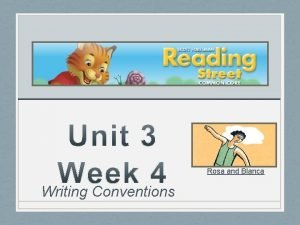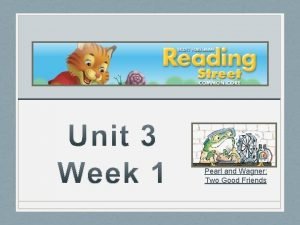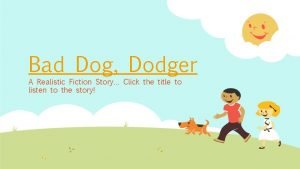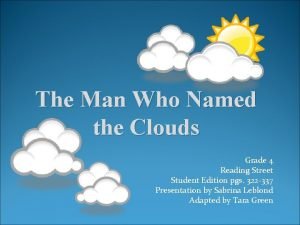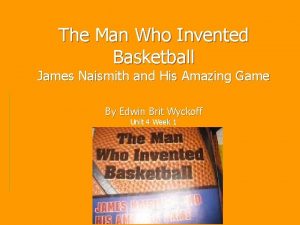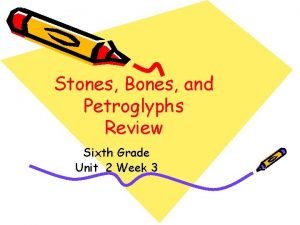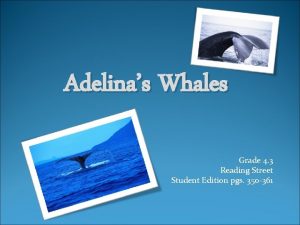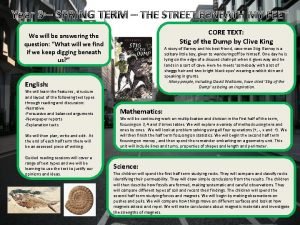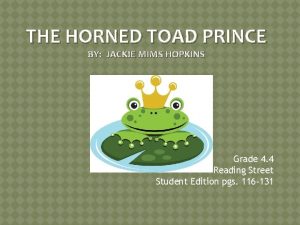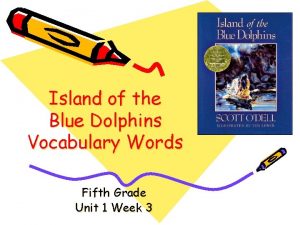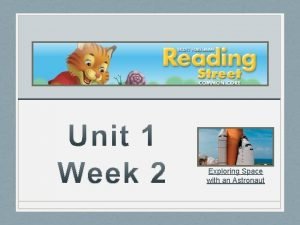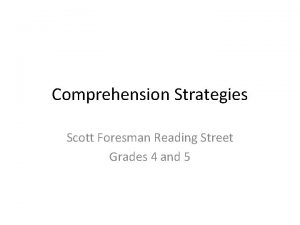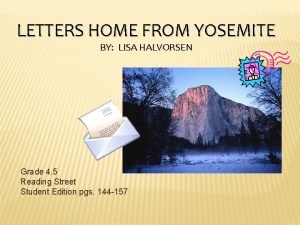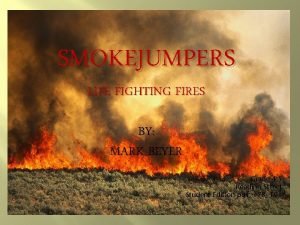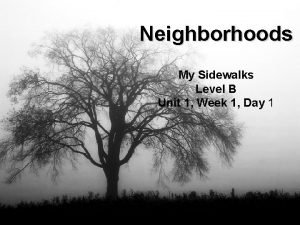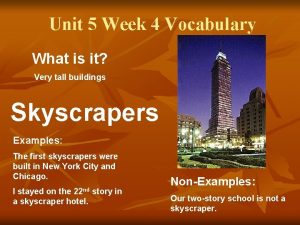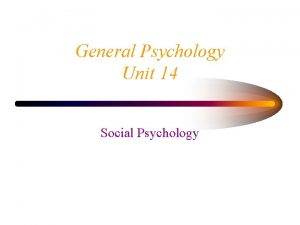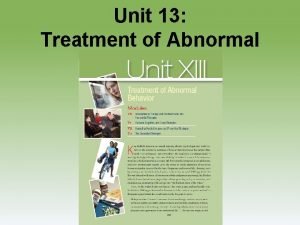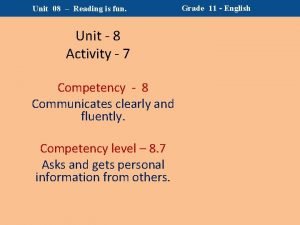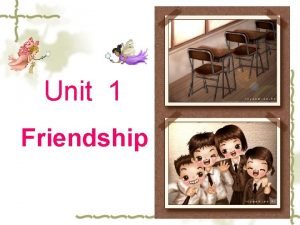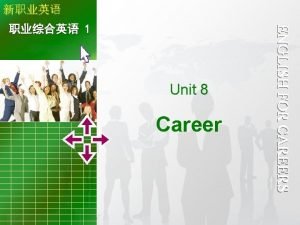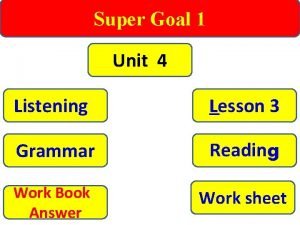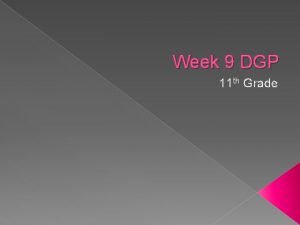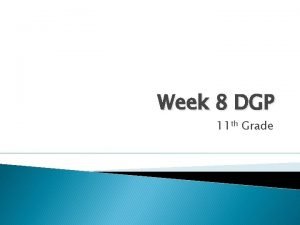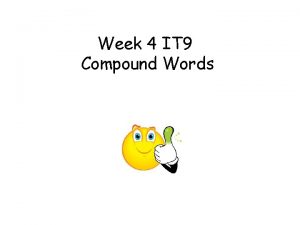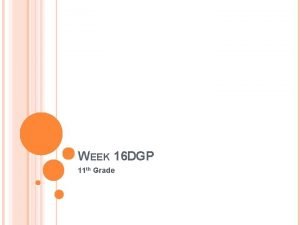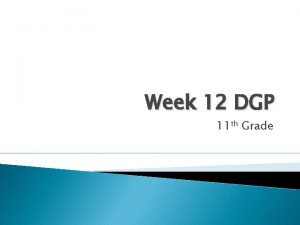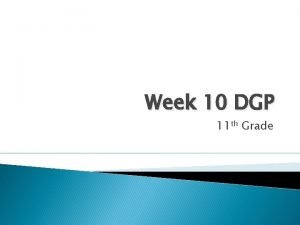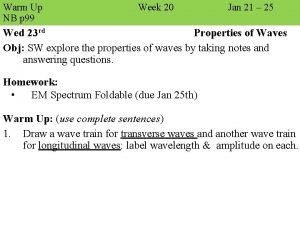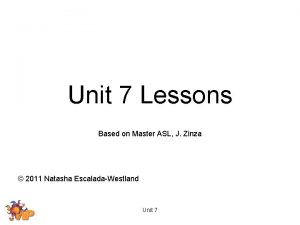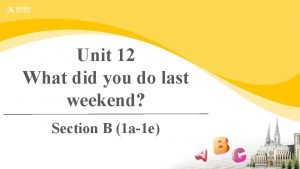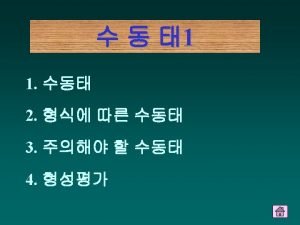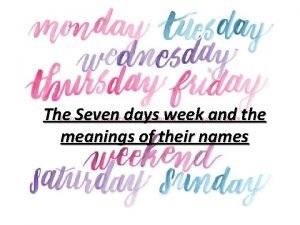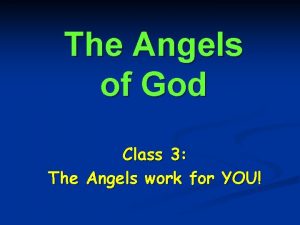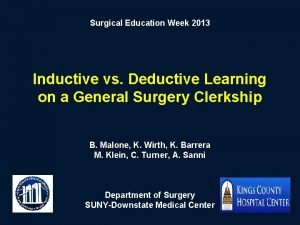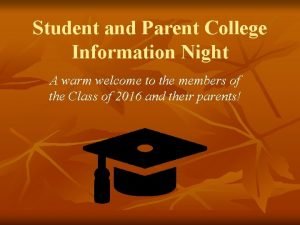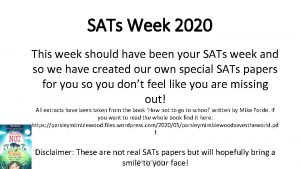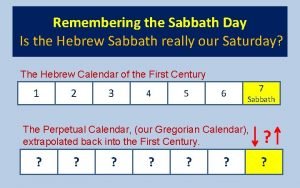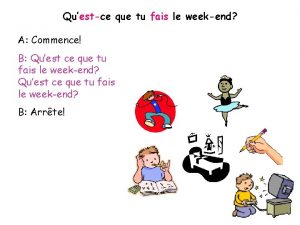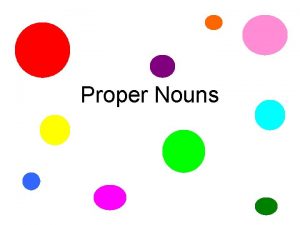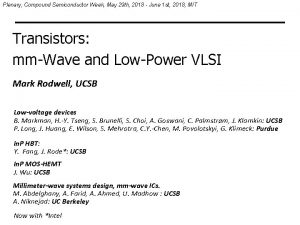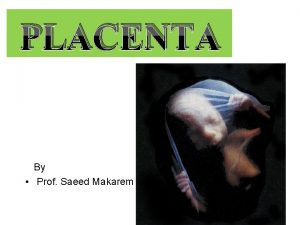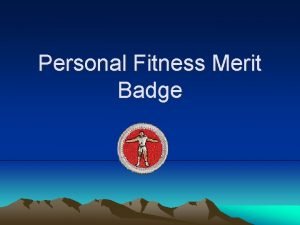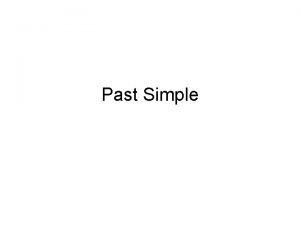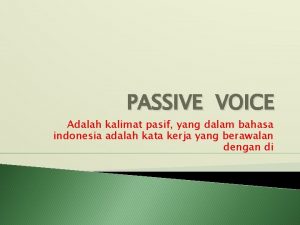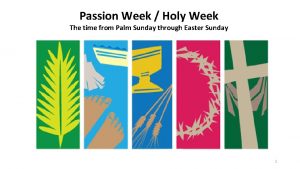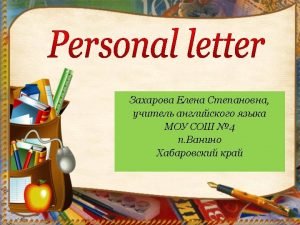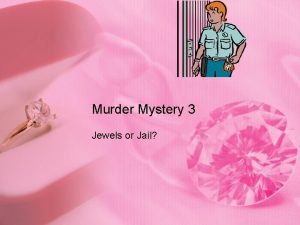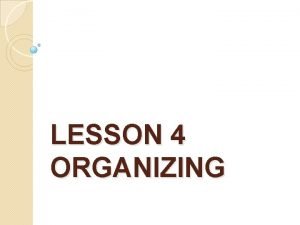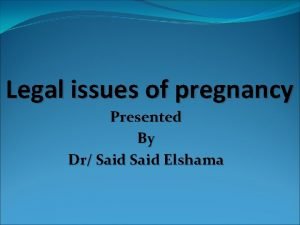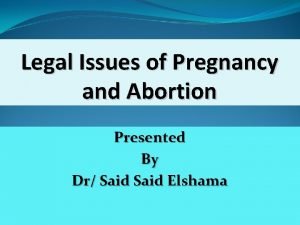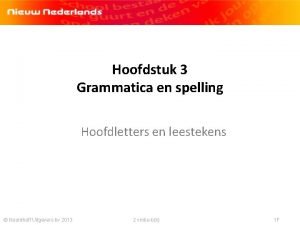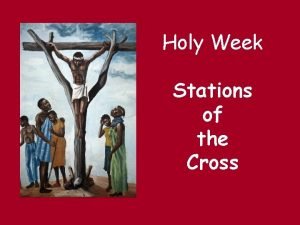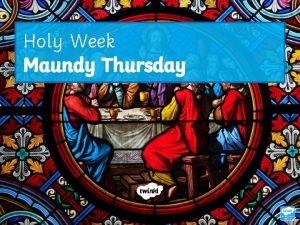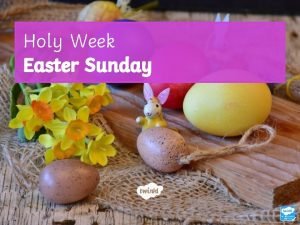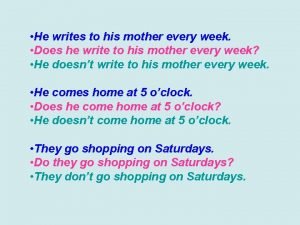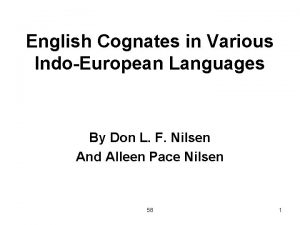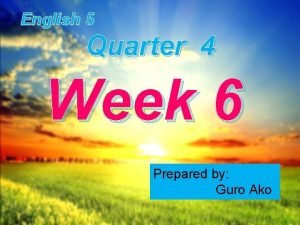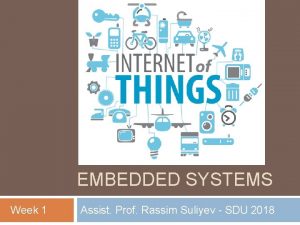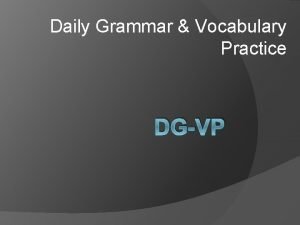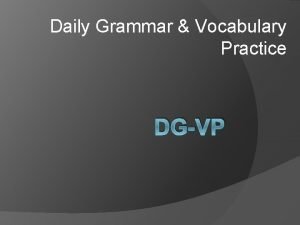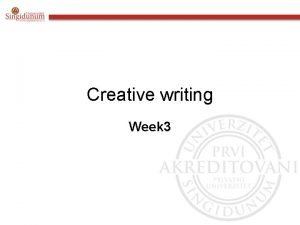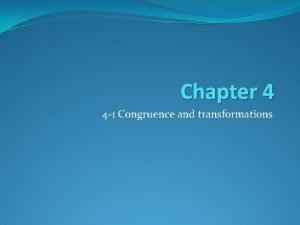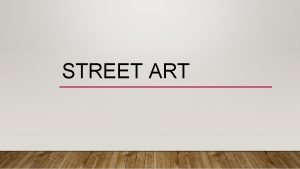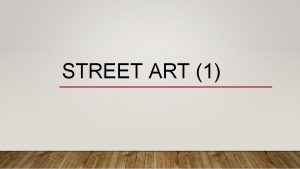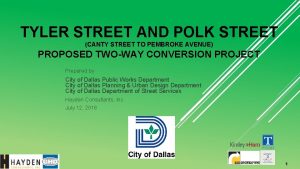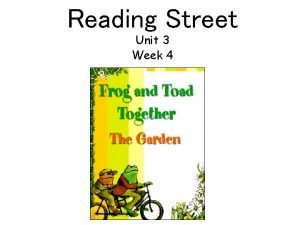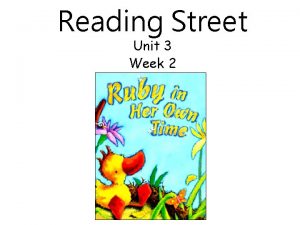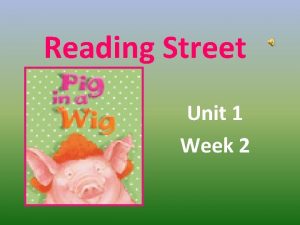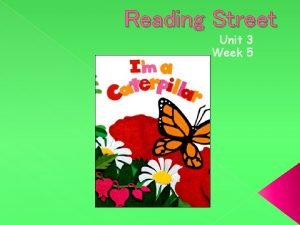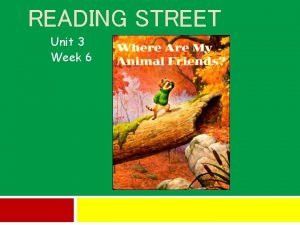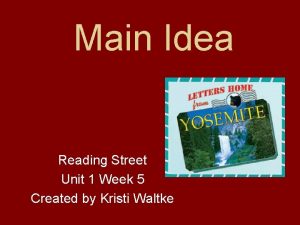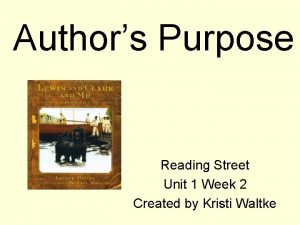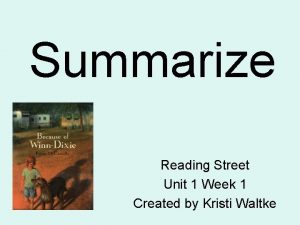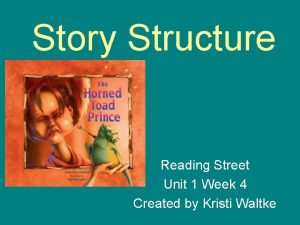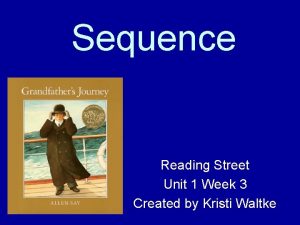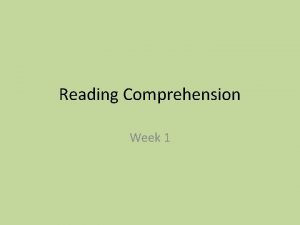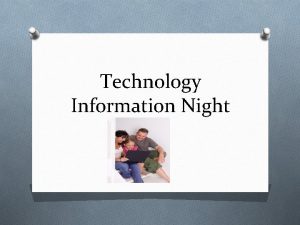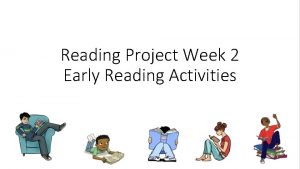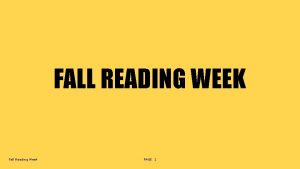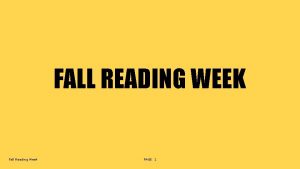Reading Street Unit 1 Week 5 How are


































































































- Slides: 98

Reading Street Unit 1 Week 5

How are people and animals important to one another? Animal Friends How do people take care of pets? How can people help animals? How can animals help people? What can we learn about animals by watching them? Which wild animals can we find in our neighborhood?

Day 1 Morning Warm Up! The fox and her kit lived in a zoo. A man gave them food to eat. Do other wild animals eat this way too? Which wild animals can we find in our own neighborhood? • What did the wild animals in A Fox and a Kit eat? Did they find their own dinner in their habitat? • Some animals in Babies on the Go get rides from a parent. How did the others go?

habitat hatch survive gentle nudge perch private moist

Time to Hatch Crack! The eggs begin to hatch now. New birds come alive. They look at their habitat to See how they can survive. Listen for the amazing words habitat, survive, and hatch. Little birdies see a pond and Feeders filled with seed. Thorny bushes they can hide in – Everything they need!

Blend and Segment Phonemes (Click to make the sounds appear, then click again for words. ) We just sang about little birdies that have everything they need. The little birdies are all set. Listen to the sounds in set ten fed let beg sell mess

bag sit e in ut Ro Vowels: Short i You studied words like these already. What do you know about reading these words? Today we will learn about words that have the short e vowel sound. This is elephant. The sound that you hear at the beginning of elephant is short e. Say it with me: /e/. jet The e in this word stands for the short e sound: /e/. This is how I blend this word. Let’s blend this word together: /j/ /e/ /t/, jet. When e is the only vowel letter in a word, it usually stands for the short e sound, /e/.

e in ut Ro Vowels: Short i Group Practice: Say the sound of each letter and blend the word together: m e n w e b y e t h e n m e ss What do you know about reading these words? When e is the only vowel at the beginning or in the middle of a word, it usually stands for the short e sound, /e/. Individual Practice: Say the sound of each letter and blend the word together: y e s w e ll p e n e gg t e n t e ll n e t f e d

Write the word red with your letter tiles. Change the r in red to b. What is the new word? Change the d to g What is the new word? Change the b to p. What is the new word? Change the p to l. What is the new word? Change the g to ss. What is the new word?

Check Word Reading (Have individuals read the following words) pet hen egg bed pen pick bell six get miss deck rag fell win lock

Pretest Short i Model Writing for Sounds: 1. bed 6. net • What sounds do you hear in pet? 2. men 7 leg 3. red 8. jet • What is the letter for /p/? 4. step 9. sled 5. ten 10. wet • In pet, the e has the short e sound: /p/ /e/ /t/, pet. • Repeat with web High-Frequency Words: 11. saw 12. your

During Small Group: 1. 2. 3. 4. Finish morning work – hanging folder. Do pages 17 of cow book – leave in. Do pages 43 of beaver book – leave in. Read your AR book again at your seat. If your folder is signed and you can test by yourself, you may take a test. If you make an 80 or 100 –Go to library. 5. Centers for Monday. Centers must be whisper centers or you will have to return to your seat. 6. Remember: If you need help, ask a friend to help you. Do not disturb small group.

DEVELOP ORAL LANGUAGE Read the title and have children view the illustration and photographs. Ask them to tell you what they see. Allow ample time for children to respond and remind them to speak in complete sentences and to add details that explain their ideas. If children are reluctant to talk, use open-ended prompts to model language use and to encourage conversation. For example: Tell me about what you see here. Yes, that's right, these are animals you might find in your neighborhood. What do you think the butterfly just did? Yes, it just hatched from its chrysalis. Why is it a good thing that the butterfly didn't hatch on the spider web? Where do the worms live? These bunnies are in the grass. Would you ever see a bunny in a tree? BUILD ORAL VOCABULARY As you continue the discussion, have children use today's Amazing Words, habitat, hatch, and survive. • How does the spider survive? • What other wild animals might you discover in a neighborhood habitat? • Which animals in the photographs hatch?

Build Background CONCEPT CHART Remind children of the question of the week. • Which wild animals can we find in our neighborhood? Ask children to name as many animals as they can. Where do worms live? What do rabbits eat? Animals in Our Neighborhood CONNECT TO READING Point out the illustration on the bottom corner of Student Edition p. 95. Ask children what the girl is doing. Explain that this week children will read a selection about this girl and her friend. Tell children that they will learn about wild animals that live in neighborhoods.

Listening Comprehension Teach/Model Realism and Fantasy DEFINE REALISM AND FANTASY • A realistic story tells about something that could happen in real life. • A fantasy is a story that could not happen in real life. • Good readers think about whether a story could or could not happen in real life. READ ALOUD Read "The Pecking Hen" (p. 95 b) and model how to distinguish between realism and fantasy. MODEL When I want to figure out if a story is realistic, I notice how the people act and what happens. In this story, Kashia and Grandma Bess act like real people act. A real girl could visit her grandmother. She could observe a hen close-up, and a hen could peck her on the nose. This story is a realistic story because it is about things that could really happen. CLUES TO REALISM AND FANTASY Ask children what other clues tell that this story could really happen. DISTINGUISH REALISM AND FANTASY Recall the story The Big Blue Ox. Can people have an ox? Can a real ox dig or mop pigs and fix their wigs? What other clues tell you that The Big Blue Ox is a fantasy? CONNECT TO READING Tell children that when they read any story, they should think about whether the story could or could not really happen.

Daily Fix-It 1. ten men sat on a jett. 2. your redd sled is wet.

Daily Fix-It 1. ten men sat on a jett. Ten men sat on a jet. 2. your redd sled is wet. Your red sled is wet.

Shared Writing GENERATE IDEAS Ask children what kinds of wild animals live in backyards or parks. Ask children to pretend to be one of these animals. Which one did they choose and why? Talk with them about what the wild animals do. WRITE ANSWERS Explain that the class will choose two wild animals found in backyards or COMPREHENSION SKILL to Have children parks and write sentences answer questions think of two real wild animals they have about them. read about for their answers. For example, a lizard and a swan from Babies on the Go. Display Writing Transparency 5 and read the title. Read the questions and invite children to suggest answers. Discuss and record answers to complete the sentence frames. HANDWRITING While writing, model the letter forms as shown on pp. TR 12– 15. READ THE ANSWERS Have children read the completed answers aloud as you track the print

Grammar: Teach/Model Telling Sentences IDENTIFY TELLING SENTENCES Display Grammar Transparency 5. Read the definition aloud. • The bird has one egg is a telling sentence. It is a statement that begins with a capital letter and ends with a period. • Statements that begin with a capital letter and usually end in a period are called telling sentences. The egg is in the nest is a telling sentence, so it begins with a capital letter and ends with a period. Continue modeling with items 1– 4.

Grammar: Telling Sentences Practice Fix-Up Telling Sentences: Have children find and correct errors in grammar and punctuation for these sentences. 1. we saw a little egg 2. a green frog hops up 3. i see the kit lick her lips


SHORT e Write red and ask children what sound the e in red has. Have children name other short e words. SPELLING SHORT e Have children name the letters for each sound in men. Write the letters as children write them in the air. Continue with ten and wet. REALISM AND FANTASY To help children distinguish realism and fantasy, ask: What clues help you know the story "The Pecking Hen" could really happen? LET'S TALK ABOUT IT Display the Animals in Our Neighborhood web. Ask children to read the names of as many animals as they can. Invite them to add more animals to the web. Can all of these animals survive in a back yard or a park? How do you know? Tomorrow the class will read more about animals and their babies.

Day 2 Morning Warm Up! Today we will read about animals. We will see which ones travel on the ground. What animals have you seen walking around? Look at the word animals in the warm-up. How do you know we’re talking about more than one animal?

Share Literature AUTHOR/ILLUSTRATOR Display the front cover of the Big Book Babies on the Go. Ask children to identify who wrote the book. Explain that authors may write books that tell stories and at other times they may write books to share information. Help children recall that this book shares information. Then identify the illustrator and lead a discussion about the work of an illustrator. BUILD ORAL VOCABULARY Ask children what they remember about how baby animals move. Point out that some travel on the ground while others travel through air or water. Suggest that as you read, children listen to find out which animals travel on the ground. • Can you name a baby animal that travels on the ground? • How does a baby polar bear travel?

habitat hatch survive gentle nudge perch private moist

Phonemic Awareness • You know that some baby animals ride on top of their mother’s back. Listen as I say the sounds in top • Listen as I add /s/ to top. s top Continue with these examples block t rack (click for onset, then click again for the ending): s pin f lap s well

Phonics: Initial blends e in ut Ro Blending Strategy top stop You studied words like these already. What is the sound at the beginning of top? Today we’ll learn about words that have two consonant letters and sounds at the beginning. The letters s and t make a consonant blend. A consonant blend has two consonant letters whose sounds are blended together. Say: /s/ /t/ /o/ /p/. The two sounds /s/ and /t/ are blended together. This is how I blend this word: Let’s blend this word together: /s/ /t/ /o/ /p/, stop. clam trim stick smell stuff

Phonics: Initial Blends cl a m tr i m sl i ck sm e ll e in ut Ro Say the sound of each letter or letters and blend the word together: st i ff What do you know about reading these words? The sounds of the two consonant letters at the beginning of the word are blended together. Call on individuals to blend these words: gl a d sp e ll br i ck fl a p sk i p cl a p tr i p gr i n sp i ll

Spell the word rip with your letter tiles. Add g to rip. What is the new word? Change the g to d. What is the new word? Change the d to t. What is the new word? Change the tr to sl. What is the new word? Change the s to f. What is the new word?

Check Word Reading Initial Blends (96 d) flip glass clock block grin frog skip snap stack spot trick slip crab dress swim

Spelling: Practice: Short e (Click to Check Dictation) I see ten men on the jet. Your sled is the red one. Do not step on the wet net. Jan hit her leg on the bed.

During Small Group: 1. 2. 3. 4. 5. Finish morning work – hanging folder. Do pages 18 of cow book – leave in. Do pages 45 of beaver book – leave in. Write spelling words 3 times VERY NEATLY - tray Read your AR book again at your seat. If your folder is signed and you can test by yourself, you may take a test. If you make an 80 or 100 –Go to library. 6. Centers for Tuesday. Centers must be whisper centers or you will have to return to your seat. 7. Remember: If you need help, ask a friend to help you. Do not disturb small group.

Ro ut ine Nondecodable Words 1. Say and Spell Look at the words on p. 96. You cannot yet blend the sounds in these words. We will spell the words and use letter-sounds we know to learn them. Point to the first word. This word is saw, s-a-w, saw. What is this word? What are the letters in this word? 2. Identify Familiar Letter-Sounds Point to the first letter in saw. What is this letter? What is the sound for this letter? (s/s/) 3. Demonstrate Meaning Tell me a sentence using this word. Repeat the routine with the other Words to Read. Have children identify these familiar letter-sounds: tree (t /t/), your (y/y/), small (s/s/, ll/l/). Have children read aloud the sentences and point to the Words to Read. Add words to the Word Wall.

Interactive Writing Write Journal Entry USE A WEB Display the Animals in Our Neighborhood web. Encourage children to read the names of the animals in the web. Picture walk through the Big Book Babies on the Go and help children identify animals that could be found in backyards or around the neighborhood. SHARE THE PEN Have children participate in writing sentences for a journal entry about animals they have seen or would like to see around the neighborhood. To begin, have a child give a sentence. Write the sentence and read it aloud, inviting the class to check the word order. Ask questions such as: What animal did you see? Did the animal travel on the ground? If not, how did it travel? What did you hear? How did you feel when you saw the animal? Continue to have individuals make contributions. Frequently reread what has been written while tracking the print. READ THE JOURNAL ENTRY Read the completed journal entry aloud, having children echo you. Example: I saw a red bird in my yard. The red bird flew through the air. I heard a chirping sound. I felt excited when I saw that bird. _________ Animals in our Neighborho od __________ _

Daily Fix-It 3. i saw two men packing a sled 4. I saw Pop stepp on a weet rock.

Daily Fix-It 3. i saw two men packing a sled I saw two men packing a sled. 4. I saw Pop stepp on a weet rock. I saw Pop step on a wet rock.

Grammar: Telling Sentences q The green frog flips and flops. • Explain why this is a telling sentence. q the frog green flips and flop • Explain why this is not a telling sentence. • Statements that begin with a capital letter and usually end in a period are called telling sentences. How do telling sentences begin and end?

Grammar: Practice – Telling Sentences Have children suggest telling sentences for these pictures of backyard animals. MODEL This is a lizard. Write lizard. I think I saw a green lizard walking on the ground would be a good telling sentence for this animal. This is a telling sentence so it begins with a capital letter. Write I saw a green lizard walking on the ground. This is a telling sentence so it ends with a period. Add a period. Have children suggest telling sentences for the other pictures. Ask them to identify words that should be capitalized and to supply the correct end punctuation mark for their sentences. Write the sentences children provide.

Speaking and Listening Retell a Story DEMONSTRATE SPEAKING AND LISTENING Have children think about the characters and events in the story The Big Blue Ox. Remind children of appropriate listening and speaking behaviors. Then ask them to think about these behaviors as you demonstrate how to retell the story. USE A STORY CHART Ask children to name the characters in the story, describe them, and tell what they did. Work together to complete a chart like the one below. Help children retell the story using the completed chart. Have them use vocabulary from the story as they retell. Use visual aids, such as pictures and objects. Characters Events Mom Ox helps dig and pick Pop Ox helps the pigs. Ox Ox helps Mom and Pop shop. Pig Ox, Mom, and Pop nap. Characters Events


üHIGH-FREQUENCY WORDS Write the following sentence: Ben saw a small blue bug in your tree. Ask children to read the sentence and identify the high-frequency words saw, small, your, tree. üSHORT e Point to the word Ben and ask children what sound the e stands for. List other short e words together. üLET'S TALK ABOUT IT Recall the Big Book Babies on the Go. Ask: Could you see any of the animals in this story in a backyard? Encourage children to check to make sure the animals are shown on the Animals in Our Neighborhood web. Tomorrow you will read about a boy and girl who help a bird.

Day 3 Morning Warm Up! Today we will read about Brad and Kim. They help a bird whose egg is in danger. What could cause danger for a real bird’s eggs?

Share Literature AUTHOR/ILLUSTRATORHelp children recall the author and illustrator. Explain that illustrators make choices in what and how they illustrate, just as authors make choices about what and how they write. Lead a discussion of the illustrations in the big book. Guide children to see that they are realistic. Discuss possible reasons the illustrator made this choice. BUILD ORAL VOCABULARY Review that yesterday the class read the book to find out which animals travel on the ground. Suggest that as you read, children listen to find out which animals travel by riding with a parent. MONITOR LISTENING COMPREHENSION • How does a baby snow monkey travel? • How does a baby kangaroo travel? • How do you think the baby animals' parents feel about giving them rides? • How do you know?

habitat hatch survive gentle nudge perch private moist

Phonemic Awareness (Click to make the sounds appear, then click again for words. ) You know that some babies stand up right away and take a step. Listen to the sounds in step flex fret s p e ck stem d r e ss s m e ll step flex fret speck stem dress smell

led sled e in ut Ro Short e and Initial Blends Connect: You can read this word because you know the sounds that the consonant letters stand for. You also know that when e is the only vowel at the beginning or in the middle of a word, the e stands for the short e sound. What sound does the e in this word stand for? . What’s the word? What sound do the letters s and l stand for in this word? What’s the word? Model: When you come to a new word, look at all the letters in the word. Think about its vowel sound and if the sounds of consonant letters can be blended together. Say the sounds in the word to yourself and then read the word. (click and model) led sled When you come to a new word, what are you going to do?

e in ut Ro Inflected Endings Group Practice: Let’s read these words. Look at all the letters, think about the vowel sounds, and say the sounds to yourself. When I point to the word, let’s read it together. (Allow 3 -4 seconds previewing time for each word. ) • • leg grab web spell

Spying on Animals I love to spy on animals That cross through my backyard. If I sit on my back step, It is not very hard. I see wrens On their nests Full of eggs. I watch spiders spin their webs and Butterflies Flying free. They spend their time with me. Can you find these words: spend, wrens, spy, cross, spiders, flying, free.

Sort Words (Have children spell these words with letter tiles and then spell other short e words with and without blends and tell which column to write each word in. ) Short e Without Blend yes Short e With Blend press

Nature Walk DISCUSS BIRDS AND THEIR NESTS Take a nature walk to observe birds and their nests, or share pictures of various birds and nests that may be found in some backyards—for example, tree swallows, bluebirds, wrens, or sparrows. Initiate discussion by asking children to share what they know about birds and their nests. Where might you find a bird nest? Why do you think birds build nests?

Build Background BACKGROUND BUILDING AUDIO Have children listen to the CD and share the new information they learned about why birds build nests. COMPLETE A MAIN IDEA CHART Draw a main idea chart or display Graphic Organizer 27. Write "Why Birds Build Nests" in the large box at the top. Ask children to give reasons why birds build nests. Add their responses to the smaller boxes.

CONNECT TO SELECTION Connect background information to Get the Egg! We know that birds build nests to make a safe place to lay their eggs. Sometimes something can happen to the egg before it hatches. Kim and Brad are characters in the story we are about to read. We’ll find out what they do to save a red bird’s egg.

Vocabulary • Read each sentence as you track the print. • Frame each underlined word. Explain the word’s meaning. bird – animal covered in feathers with wings and two legs nest – a bird’s home • Ask children to identify familiar letter sounds, bird (/b/ /i/ /r/ /d/). • Have children read each sentence aloud with you. Then introduce the character names Kim and Brad. • To encourage discussion using the selection words, invite children to create sentences based on their real-life experiences. Have individuals use bird and nest in their sentences.

Monitor Progress Check High-Frequency Words (Point to the following words and have individuals read them. ) saw small tree your are the too you

During Small Group: 1. 2. 3. 4. Finish morning work – hanging folder. Do pages 19 of cow book – leave in. Do pages 46 of beaver book – leave in. Read your AR book again at your seat. If your folder is signed and you can test by yourself, you may take a test. If you make an 80 or 100 –Go to library. 5. Centers for Wednesday. Centers must be whisper centers or you will have to return to your seat. 6. Remember: If you need help, ask a friend to help you. Do not disturb small group.

Comprehension Skill Realism and Fantasy RECOGNIZE REALISM AND FANTASY Review that a realistic story could really happen and a fantasy could not. Recall previously read realistic stories and fantasies. Guide children in identifying things that could and could not really happen. CONNECT TO READING • As you read, notice things in the story that real people would say and do. • Ask yourself if everything in the story could really happen.

Comprehension Strategy: Story Structure INTRODUCE THE STRATEGY Explain that knowing the important parts of a story— the characters, the setting, and what happens—can help children understand remember the story. MODEL When I read a story, I ask myself who the story is about, where and when it takes place, and what happens. CONNECT TO READING Encourage children to ask themselves these questions as they read Get the Egg! • Who are the characters in this story? • Where and when does this story take place? • What happens at the beginning of the story? in the middle? • How does the story end?

Fluency READ WITH ATTENTION TO PUNCTUATION MODEL ATTENDING TO PUNCTUATION Use Get the Egg! Point to the periods in each sentence on p. 100. A period shows that it is the end of a sentence. I stop when I come to a period. Ask children to follow along as you read the page. Stop at each period. Have children read the page after you. Encourage them to read, stopping for each period. Continue in the same way with pp. 101– 102. e in ut Ro Choral Reading Select a Passage For Get the Egg!, use pp. 100– 103. Divide into Groups Assign each group a part to read. For this story, use these parts: the narrator, Brad, Kim. Model Have children track the print as you read. Read Together Have children read along with you. Independent Readings Have the groups read aloud without you. Monitor progress and provide feedback. For optimal fluency, children should reread three to four times.

Vocabulary EXPAND ORAL VOCABULARY Display the Animals in Our Neighborhood web. Use the web to help children group animals with habitats that are alike. Model how to compete the first row of the chart. Continue discussing animals that live in each of the other habitats. If necessary, display p. 32 of the Big Book Babies on the Go to help children find animals that live in each habitat. Have partners copy the chart and work together to add to the remaining rows of the chart. Invite volunteers to share their completed charts. A habitat is a place where an animal lives, eats, sleeps, and builds or finds its home. ______ habitat _____ Animals in our Neighborhood ___________ animal

Vocabulary CLASSIFY WORDS DISCUSS AMAZING WORDS Discuss with children the meaning of the word habitat. Explain that a habitat is a place where an animal lives, eats, sleeps, and builds or finds its home. Help them recall that in the story, Get the Egg! children found a bird's nest in a tree. Then have children think of sentences to describe what Brad and Kim did and what they saw the red bird do. Encourage them to use the words habitat, survive, and hatch in their sentences. Click for sentence examples: The red bird lives in a backyard habitat. Brad and Kim helped a baby bird survive. They saw six eggs hatch.

Daily Fix-It 5. Yor legg got wet in the pond. 6. We caw Tim get a nett to use.

Daily Fix-It 5. Yor legg got wet in the pond. Your leg got wet in the pond. 6. We caw Tim get a nett to use. We saw Tim get a net to use.

Writing Trait of the Week Introduce Organization/Paragraphs TALK ABOUT ORGANIZATION/PARAGRAPHS Explain to children that organization is arranging the ideas in their writing in an order that makes sense. Ask children to think about how the author organizes her ideas in Get the Egg! Then model your thinking. MODEL When I look back at the selection, I see that the author tells what happens first, next, and last. I'll write some events that happen in the story. Check to see if they are in the right order. (Click for practice on next two frames. )

Writing Trait of the Week (109 c) (Sequence the sentences by writing the correct order in the boxes to the left, then click to read in correct order in a paragraph. ) q Brad puts the egg back in the nest. q A big twig knocks an egg out of a nest. q Brad uses his net to get the egg. A big twig knocks an egg out of a nest. Brad uses his net to get the egg. Brad puts the egg back in the nest.

Writing Trait of the Week (109 c) (Sequence the sentences by writing the correct order in the boxes to the left, then click to read in correct order in a paragraph. ) q The red bird lays eggs in the nest. q Baby birds hatch from the eggs. q The red bird makes a nest in a tree. The red bird lays eggs in the nest. Baby birds hatch from the eggs.

Grammar Apply to Writing Telling Sentences IMPROVE WRITING WITH TELLING SENTENCES Point out to children that writing telling sentences can give readers information about something that happened in the past. Remind children to use telling sentences in their own writing. Write Sam, Pig, Ox, Fox. Have children supply telling sentences for each story character. Ask how each telling sentence should begin and end. PRACTICE WRITE TELLING SENTENCES Call on individuals to supply more sentences to be added for each character. Ask children to check that each sentence begins with a capital letter and ends with a period. Continue until three or more sentences have been written for each story character. Character Sam Pig Ox Fox What Happened


üREALISM AND FANTASY Have children recall what happened in the story Get the Egg! Could children save an egg in real life or only in a make-believe story? Why or why not? üSTORY STRUCTURE Help children retell the beginning, middle, and end of the story. (Kim and Brad saw a nest full of eggs. An egg fell out. The children got the egg and put it back in the nest. The children saw that the six eggs in the nest all hatched. ) üLET'S TALK ABOUT IT Display the Animals in Our Neighborhood web from Day 1. What animals might be found in your backyard habitat? Tomorrow you will read about a way to help birds eat.

Day 4 Morning Warm Up! Did you ever see a bird perched in a tree? Did you watch it resting in a nest? Today we will read about a way we can help birds eat. What other animals can we help that live in a backyard?

Share Literature ACTIVATE PRIOR KNOWLEDGE Have children recall what animal in the story Get the Egg! find. Explain that today you will read another story about a child who finds a different animal. BUILD ORAL VOCABULARY Help children recall that animals live in different habitats. Guide a discussion that leads children to understand that some animals like dry habitats while others like moist, or wet, habitats. Ask children to listen to find out what kind of habitat Maisie’s toad likes. REVIEW ORAL VOCABULARY After reading, review all the Amazing Words for the week. Have children take turns using them in sentences that tell about the concept for the week. Then talk about the Amazing Words they learned in other weeks and connect them to the concept as well. For example, ask: • What would you do if you observed a spider dangling from its web? • Would a backyard turtle fetch her baby and carry it by the nape of its neck?

habitat hatch survive gentle nudge perch private moist

Phonemic Awareness • Can you picture Maisie filling the tiny pond with water? Filling has two syllables. Listen to the syllables in filling: (Model saying each word part, fill – ing, as you divide the word into two syllables. Then, click and say the word parts as they appear. Continue dividing other words into syllables as you click. ) fill ing passing kick ing pack ing lock ing

Review Phonics Review Inflected Endings –s and -ing taps mixing Look at this word. You can read this word because you know how to blend the base word and the ending –s together. Blend the sounds in the base word. What is the base word? Remember that ending –s can stand for /s/ or /z/. Now blend the two parts. What is the word? You can read this word because you know how to blend the base word and the –ing ending. Blend the base word. What is the base word? Blend the base word and the –ing ending. What is the word?

Review Phonics When I read a word, hold a hand up high if it has an –s ending and shake your head no if it has an –ing ending. (Click to sort after reading. ) -s • yelling • packs • hits • eating • naps • looking • wags • helping • taps • licking packs hits naps wags taps -ing yelling eating looking helping licking

Word Reading Read Decodable and High-Frequency Words (Encourage children to preview each word before reading it. ) Tom kicks man where did eat too sits her packing this naps look of pad said locking van hops pot

Word Reading Read Words in Context (Call on individuals to read a sentence. Then randomly point to the review words and have them read. ) • Did you see where Tom sits and naps? • “I will eat a pot of this too, ” said Nick. • Look at the man packing and locking the van. • The frog hops and kicks to get to her pad.

Partner Review Short e READ AND WRITE Supply pairs of children with index cards on which the spelling words have been written. Have one child read a word while the other writes it. Then have children switch roles. Have them use the cards to check their spelling. 1. bed 6. net 2. men 7 leg 3. red 8. jet 4. step 9. sled 5. ten 10. wet High-Frequency Words: 11. saw 12. your

Fluency MODEL READING WHILE ATTENDING TO PUNCTUATION Use Get the Egg! Point to the periods on p. 100. Review that a period is at the end of many sentences. When I come to a period, I know it is the end of a sentence. I stop when I come to a period to show that the sentence ends. Ask children to follow along as you read the page, stopping at each period. Have children read the page after you. Encourage them to read, stopping for each period. Continue in the same way with pp. 101– 102. e in ut Ro Choral Reading Select a Passage For Get the Egg!, use pp. 103– 105. Divide into Groups Assign each group a part to read. For this story, have each group read one page. Model Have children track the print as you read. Read Together Have children read along with you. Independent Readings Have the groups read aloud without you. Monitor progress and provide feedback. For optimal fluency, children should reread three to four times.

During Small Group: 1. 2. 3. 4. Finish morning work – tray. Do pages 20 of cow book – tray. Do pages 47 -48 of beaver book – leave in. Read your AR book again at your seat. If your folder is signed and you can test by yourself, you may take a test. If you make an 80 or 100 –Go to library. 5. Centers for Thursday. Centers must be whisper centers or you will have to return to your seat. 6. Remember: If you need help, ask a friend to help you. Do not disturb small group.

Writing Across the Curriculum Write Poster BRAINSTORM Have children look at pp. 110– 111 of the story "Help the Birds" and describe how to make the bird feeder. Ask them to tell how making a bird feeder helps the birds. Encourage them to use oral vocabulary, such as habitat, survive, and perch. SHARE THE PEN Have children use their opinions about helping birds to participate in writing sentences for a poster. Explain that writers can convince others to do things they think are important by writing sentences that tell about it. Then explain that the class will work together to write sentences for a poster to encourage other people to help birds. Call on individuals to suggest sentences. Write the sentences, inviting individuals to check the grammar and end punctuation. Ask questions, such as the following: Does the sentence begin with a capital letter? Does the sentence end in a period? Does the order of the words in the sentence make sense? How do you know? Continue having individuals contribute sentences that could be used on a poster. Frequently reread the sentences.

Grammar Review Telling Sentences Define Telling Sentences What is a statement that tells about something called? How do telling sentences begin and end? REVIEW TELLING SENTENCES Write the following sentence pairs on the board. Have children copy the pairs and draw a line under the telling sentences. Allow individuals to share their work with the class. 1. The bird sits in its nest. the bird sits in its nest 2. a frog flops in the pond A frog flops in the pond. 3. the fox licks its lips The fox licks its lips.

Daily Fix-It 7. the mix is a hitt. 8. This mix winz too

Daily Fix-It 7. the mix is a hitt. The mix is a hit. 8. This mix winz too This mix wins too.


FLUENCY Write Six baby birds look at me. They like to eat. The little birds eat up in a tree. Read the sentences with no mistakes, stopping at the end of each sentence. Did I make any mistakes? Did I stop at the end of each sentence? Call on individuals to read the sentences with no mistakes, stopping at each period. LET'S TALK ABOUT IT Display the Animals in Our Neighborhood web. Help children check the animals on the web to be sure that birds are shown. Discuss and add other animals children suggest. You heard a story about a girl who caught and took care of a toad. Tomorrow you will hear about her toad again.

Day 5 Morning Warm Up! This week we read about many wild animals. A baby polar bear gets a gentle nudge. Another baby animal has a private perch. Why does a wild animal pick a certain habitat?

Share Literature Listen and Respond USE PRIOR KNOWLEDGE Review that yesterday the class listened to find out what kind of habitat Maisie's toad likes. Suggest that today the class listen to find out if you might be able to find a toad in your backyard. MONITOR LISTENING COMPREHENSION Where did Maisie catch the toad? Where did Maisie learn how to feed and take care of the toad? Was the moist dirt a good place for Maisie to make a home for the toad? Why or why not? Build Oral Vocabulary GENERATE DISCUSSION Recall what Maisie catches in the garden. Ask children why it is important to leave backyard animals in their habitat. Invite children to share their own experiences similar to Maisie's. Have children use some of this week's Amazing Words as they describe the wild animals they've found in their backyard or neighborhood and what they did with them.

habitat hatch survive gentle nudge perch private moist

Short e and Initial Blends Review IDENTIFY SHORT e AND INITIAL CONSONANT BLEND WORDS Have children read each sentence aloud as you track the print. Call on individuals to name and underline the words with short vowel e or initial consonant blends. The clam and the crab will get wet. I have ten blocks and six bricks. Look at the red and black sled. I can skip and Ben can swim.

High-Frequency Words – Review (Read the rhyme. Ask children to complete each line with one of the Words to Read in the word box. ) saw tree your small Where is _______ your nest, birdie? How _______ can it be? small saw I think I just _____ it. tree In that big oak _____!

Spelling Test – Short I (Use these sentences for reading or dictation practice. ) DICTATION SENTENCES Use these sentences to assess this week's spelling words. 1. The frog got wet. 2. The man fed the red hen. 3. Get it with a net. 4. I hit my leg on the rocks. 5. The men will fix the deck. 6. Ten kids are going. 7. Will you get on the big jet? 8. Dad is fixing my sled. 9. Step on the dock. 10. I nap in my bed. HIGH-FREQUENCY WORDS 11. I saw a big cat. 12. Kick it with your leg.

LOOK AT THE PROMPT Read p. 112 aloud. Have children select and discuss key words or phrases in the prompt. STRATEGIES TO DEVELOP ORDER Have children • read aloud pages from familiar stories and talk about the order of the sentences on each page. • look at sets of three scrambled sentences you write on the board or chart paper and tell you how to write the sentences in an order that makes sense. • suggest a sentence that tells what happens next after you offer a pair of sentences such as these: Ava gets a glass. Ava takes the milk carton out of the refrigerator.

Daily Fix-It 9. You can use my nett 10. stepp up here to see a bird.

Daily Fix-It 9. You can use my nett You can use my net. 10. stepp up here to see a bird. Step up here to see a bird.

Reseach/Study Skills Teach/Model List MODEL USING A LIST Explain that people make lists for different reasons, such as to keep track of assignments or things to do. Tell children that people write lists using words, phrases, or sentences. Also, point out that lists may be numbered. Have children look at the list in Help the Birds. Discuss the list and guide children to recognize that it has numbered sentences and pictures. Point out that the numbered list is arranged in order from the least to greatest numeral. Read the list aloud with children tracking the print as you read. Then model how to use a list. MODEL First, I see that this kind of list must be read from top to bottom. So, I begin by reading the first sentence and looking at the picture that follows the number one. Then I read, in order, the rest of the sentences that follow the numbers 2– 4. I see that this is a to-do list. I know this because the sentences are in order and tell what to do to make a bird feeder. (Click for practice. )

Practice DEMONSTRATE MAKING A LIST Have partners make their own list. Tell children that some lists group things that are alike, such as a grocery list. Explain that this kind of list would have groups like Dairy, Meat, Fruits and Vegetables, Canned Goods, Breads and Cereals. Call on individuals to suggest items that belong in each group. Then have partners work together to make their own grocery lists. (Click for example. ) GROCERIES Dairy cheese milk Meat hamburger Fruits and Vegetables apples peaches peas Bread and Cereals oatmeal crackers


Click here to listen to the story: Wrap Up Your Week! QUESTION OF THE WEEK Recall this week's question. Which wild animals can we find in our neighborhood? Display the Things Animals in our Neighborhood web. Help children identify animals that are listed in the web and tell about them. For example, children can describe where these animals live and what they eat. CONNECT Use questions such as these to prompt a discussion. • What kinds of wild animals can survive in a backyard habitat? • Wild animals need certain things in order to live. Which wild animals do you think can survive in a forest habitat? • The baby kangaroo in our Big Book had a private perch in which it rode. What kind of perch do you think big cats might use when they rest from a hunt? ______ ___ Animals in our Neighborho od ______ Next week you will read about wild animals such as giraffes, hippos, and zebras.
 Insidan region jh
Insidan region jh While reading activities
While reading activities Week by week plans for documenting children's development
Week by week plans for documenting children's development Rosa and blanca
Rosa and blanca Pearl and wagner two good friends
Pearl and wagner two good friends Bad dog dodger reading street
Bad dog dodger reading street The man who named the clouds
The man who named the clouds Man who invented basketball
Man who invented basketball Stones bones and petroglyphs
Stones bones and petroglyphs Adelina's whales reading street
Adelina's whales reading street The street beneath my feet guided reading
The street beneath my feet guided reading Reading street the horned toad prince
Reading street the horned toad prince Ten mile day reading street vocabulary
Ten mile day reading street vocabulary Island of the blue dolphins vocabulary chapter 1-5
Island of the blue dolphins vocabulary chapter 1-5 Exploring space reading street
Exploring space reading street Scott foresman reading street grade 4 stories
Scott foresman reading street grade 4 stories Letters home from yosemite reading street
Letters home from yosemite reading street Smokejumpers reading street
Smokejumpers reading street Unit 6 review questions
Unit 6 review questions List of things a to z
List of things a to z My sidewalks level b unit 2 week 5 fluency sentences
My sidewalks level b unit 2 week 5 fluency sentences Unit 5 week 4
Unit 5 week 4 Round robin reading vs popcorn reading
Round robin reading vs popcorn reading Difference between silent reading and reading aloud
Difference between silent reading and reading aloud What are types of reading
What are types of reading Guided reading vs shared reading
Guided reading vs shared reading It is an active process of discovery
It is an active process of discovery Intensive reading and extensive reading
Intensive reading and extensive reading Extensive reading
Extensive reading How to develop reading skills in students
How to develop reading skills in students Unit 14 reading guide social psychology
Unit 14 reading guide social psychology Unit 13 reading guide treatment of abnormal behavior
Unit 13 reading guide treatment of abnormal behavior Grade 8 english unit 8
Grade 8 english unit 8 Unit 1 friends
Unit 1 friends English for your career 1
English for your career 1 [email protected]
[email protected] Surplus keuangan adalah
Surplus keuangan adalah Hyp opp adj
Hyp opp adj Si vs english units
Si vs english units Algebra 2 unit test
Algebra 2 unit test Unit cost rekam medis
Unit cost rekam medis Unit process and unit operation
Unit process and unit operation Difference between unit process and unit operation
Difference between unit process and unit operation Kerangka konseptual standar akuntansi pemerintahan
Kerangka konseptual standar akuntansi pemerintahan Htcondor week
Htcondor week Htcondor vs slurm
Htcondor vs slurm Med tech week
Med tech week Dgp week 11 answers
Dgp week 11 answers Dgp week 8
Dgp week 8 Sun compound words
Sun compound words Dgp week 16
Dgp week 16 Cannibal canoe hurricane and barbecue
Cannibal canoe hurricane and barbecue Dgp week 10
Dgp week 10 Dgp week 20 answers
Dgp week 20 answers Tv turn off week
Tv turn off week Unit 7 comprehension test asl
Unit 7 comprehension test asl What did you last weekend
What did you last weekend What did you do last friday
What did you do last friday Days of the week in kanji
Days of the week in kanji 4형식
4형식 Norse days of the week
Norse days of the week Omer meroz
Omer meroz Inductive vs deductive learning
Inductive vs deductive learning Cfnc free application week
Cfnc free application week Stem person of the week
Stem person of the week Sats week
Sats week 8 day week
8 day week Qu'est-ce que tu fais le week end
Qu'est-ce que tu fais le week end Author is a proper noun
Author is a proper noun Compound semiconductor week
Compound semiconductor week When does placenta form
When does placenta form Boy scout physical fitness merit badge
Boy scout physical fitness merit badge Did you play football yesterday tense
Did you play football yesterday tense The teacher punished his students for not doing homework
The teacher punished his students for not doing homework Passion week timeline
Passion week timeline A company manufactures and sells x cellphones per week
A company manufactures and sells x cellphones per week 5-a-day language review week 17 answer key
5-a-day language review week 17 answer key Writing about my friend birthday party
Writing about my friend birthday party 2 week dating challenge
2 week dating challenge 40-hour work week schedule examples
40-hour work week schedule examples 1 week darkening areola early pregnancy pictures
1 week darkening areola early pregnancy pictures 1 week darkening areola early pregnancy pictures
1 week darkening areola early pregnancy pictures Dagen van de week hoofdletter engels
Dagen van de week hoofdletter engels Stations of the cross holy week
Stations of the cross holy week Learning outcomes of holy week
Learning outcomes of holy week Learning outcomes of holy week
Learning outcomes of holy week He writes to his mother every week
He writes to his mother every week Week 22 growing pains for the new nation
Week 22 growing pains for the new nation Greek week themes
Greek week themes Iugr full form
Iugr full form Latin days of the week
Latin days of the week English 5 quarter 1 week 6
English 5 quarter 1 week 6 Koroui
Koroui Dyslexia awareness week 2020
Dyslexia awareness week 2020 Dgp week 14 answers
Dgp week 14 answers Ensnare in a sentence
Ensnare in a sentence Creative writing week 3
Creative writing week 3 4-7 practice congruence transformations
4-7 practice congruence transformations Alyson klein
Alyson klein



